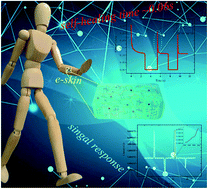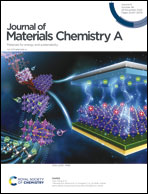A direction-aware and ultrafast self-healing dual network hydrogel for a flexible electronic skin strain sensor†
Abstract
As an important part of artificial intelligence, electronic skin has received more and more attention recently. However, two serious issues, slow self-healing and lack of direction recognition, have limited the burgeoning of electronic skin largely. Herein, for the first time we report a dual network flexible hydrogel, which was synthesized via cross-linking polyvinyl alcohol (PVA) and polyethylenimine (PEI) with 4-formylbenzoboric acid (Bn) to form a polymer network and then incorporating MXene into the polymer network. Due to the synergy of multiple reversible dynamic covalent bonds and supramolecular interactions, the PVA/Bn/PEI/MXene (PBPM) hydrogel exhibits direction-aware and ultrafast self-healing abilities (self-healing time ∼0.06 s) as well as rapid response performance (signal response time ∼0.12 s). Furthermore, an electronic skin strain sensor assembled by using the PBPM hydrogel can not only efficiently detect the movements in different parts of the prosthetic person body but also specifically identify the directions of the movements including head-down/up and wrist-down/up. The flexible PBPM hydrogel in this work has shown great potential in the applications of artificial skin, soft robots, health monitoring and human-machine exchange interfaces.



 Please wait while we load your content...
Please wait while we load your content...